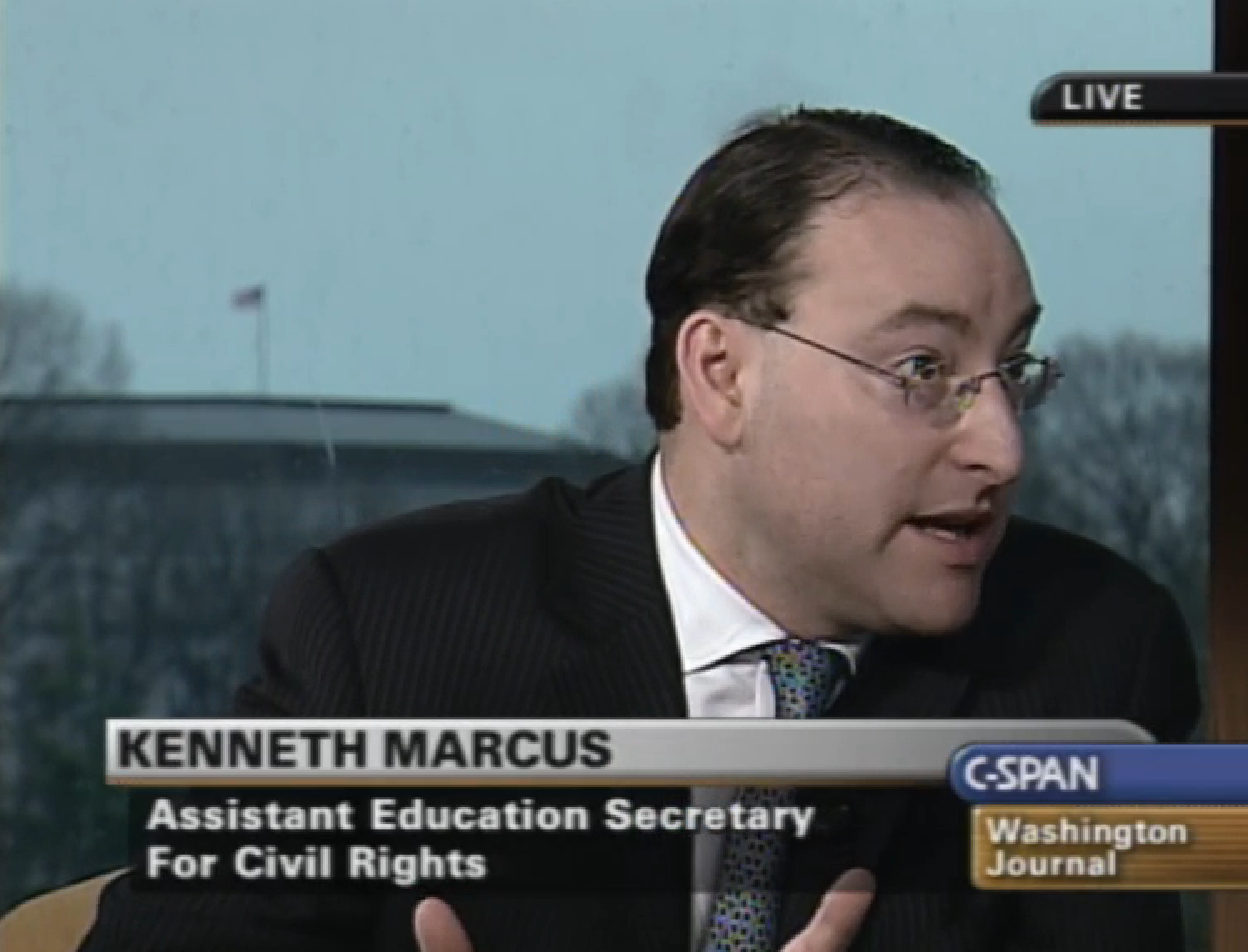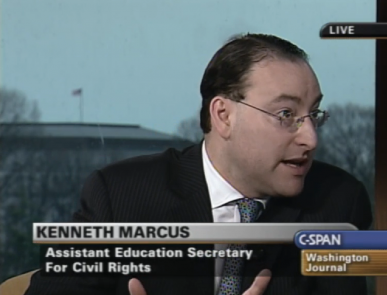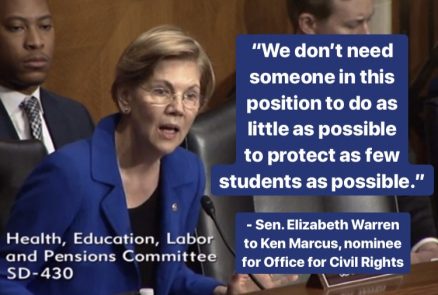Abortion rights, women of color, and LGBTQI+ people are under attack. Pledge to join us in fighting for gender justice.
Surprise, Trump’s New Civil Rights Nominee Is Anti-Civil Rights


We’re living in a new Dark Age. Our Secretary of Education doesn’t believe in public schools. Our president doesn’t believe in facts. Is it any surprise that our nominee for Assistant Secretary for Civil Rights doesn’t believe in civil rights?
Just yesterday, Kenneth Marcus told the Senate that he can’t name a single civil rights violation committed by the Trump administration. This is the man who wants to lead the Department of Education’s Office for Civil Rights (OCR). This is the man who would enforce federal anti-discrimination statutes to ensure that all students have equal access to education.
As Senator Elizabeth Warren put it, “We don’t need someone in this position to do as little as possible to protect as few students as possible.”

Here are six of Marcus’s worst anti-civil rights positions:
1. Marcus supports Betsy DeVos’s attack on sexual assault survivors.
Marcus told the Senate that he agrees with Secretary DeVos’s decision to rescind Title IX guidance on sexual assault. Apparently, he thinks it was a good idea to replace 72 pages of detailed guidance with a scant 10 pages of confusing guidance that gives special rights to accused rapists.
Marcus also claimed that the Office for Civil Rights shouldn’t have required schools to use the preponderance of the evidence standard in Title IX investigations—even though OCR required schools to use the preponderance standard the last time he was in charge. Marcus might be willing to throw sexual assault survivors under the bus in order to get this new job, but we always keep receipts:

2. Marcus doesn’t think Title VI protects undocumented students.
Back in 1982, the Supreme Court ruled that schools can’t deny undocumented children access to public education. The Office for Civil Rights followed up with guidance in 2014, reminding schools that Title VI prohibits discrimination on the basis of a student’s citizenship status.
But at his Senate hearing, Marcus said he didn’t think he would be responsible for protecting undocumented students, claiming (wrongly) that he “lacked jurisdiction.” As the Trump administration continues its attacks on undocumented children, Mexicans, and Muslims, Marcus’s apathy toward undocumented students is incompatible with the purpose of the Office for Civil Rights.
3. Marcus doesn’t think Title IX protects LGBTQ students.
Between the Departments of Education and Justice’s rescission of their transgender guidance, and the White House’s transgender military ban, LGBTQ rights are squarely under attack. But Marcus doesn’t seem to think this is a problem.
In 2004, as Assistant Secretary for Civil Rights, Marcus was outraged by a professor who rebuked a white male student for expressing “conservative Christian views” about homosexuality. He promised to “aggressively prosecute” schools that engaged in what he considered “religious harassment” of conservative Christian students but somehow (very mysteriously) forgot to denounce anti-LGBTQ harassment. Years later, during a USCCR discussion on bullying, including anti-LGBTQ bullying, he again (very mysteriously) forgot to denounce anti-LGBTQ harassment as a form of harassment prohibited by Title IX.
It’s bad enough that Marcus is unlikely to protect LGBTQ students. It’s even worse that he might “aggressively prosecute” schools that discipline anti-LGBTQ harassers, on the basis that these harassers are victims of so-called “religious harassment.” At a minimum, he’s displayed no interest in enforcing the civil rights of students who are harassed or assaulted based on their sexual orientation, gender identity, and/or gender expression.
4. Marcus thinks affirmative action is reverse discrimination.
Affirmative action is a race-conscious (or gender-conscious, etc.) policy that seeks to correct the effects of historical and present-day discrimination. While Marcus supports a “color-blind society,” he doesn’t seem to recognize that colorblindness is in itself a form of racism.
You might be wondering—if you can’t see race, then how do you identify and fight racism? Well, the answer is that you don’t. As Assistant Secretary for Civil Rights, Marcus published a 2004 report encouraging schools to use “race-neutral policies” instead of race-based affirmative action. Later, as Staff Director for the U.S. Commission on Civil Rights, he followed up with a 2007 report recommending that law schools no longer be required to “demonstrate a commitment to diversity.”
Why does Marcus oppose affirmative action? It might be because he thinks that “cultural dysfunction” and “family structure”—rather than historical and present-day discrimination—are the primary causes of racial disparity between black and white individuals. It might be because he believes in the myth of reverse-racism (as does his predecessor Candice Jackson), and that race-conscious policies designed to promote workplace equality actually “reflect racial prejudice” against white people.
In any case, Marcus’s views on affirmative action make him unqualified to lead the Office for Civil Rights. Anyone who doesn’t understand how racism works and who holds such regressive racial stereotypes is unfit to lead an agency charged with enforcing protections against racial discrimination.
5. Marcus thinks sexist stereotypes are a legitimate basis for offering single-sex education.
There is overwhelming empirical evidence that single-sex education does not improve educational outcomes and that it reinforces harmful gender stereotypes. But Marcus does not appear to believe in science or in protecting the Title IX rights of girls and women (don’t worry, he’ll fit right in with the Trump administration).
In 2004, as Assistant Secretary for Civil Rights, Marcus was responsible for single-sex education regulations that invited schools to create separate-and-unequal programs based on pseudoscientific preferences and beliefs—programs that could violate the Constitution’s Equal Protection Clause. Since the regulations were issued, single-sex education has increased sharply in public schools across the country, causing a resurgence of appallingly regressive gender stereotypes in the classroom. It became so alarming that the Department of Education issued guidance in 2014, clarifying that schools cannot rely on “overbroad generalizations” about the ability or preferences of either sex in offering single-sex programs.
“Our kids were basically being taught ideas about gender that come from the Dark Ages,” a parent from Mobile, Alabama reported. In one Pittsburgh kindergarten, boys learned vocabulary by playing basketball and running relay races, while girls learned vocabulary through fairytale stories, wands, and tiaras. In a Wisconsin school district, boys were asked “what would you do,” while girls were asked “how would you feel?”
As the popularity of single-sex education continues to grow, it’s clear that Marcus must not be given a second opportunity as Assistant Secretary for Civil Rights to roll back gender equity further.
6. Marcus doesn’t believe in disparate-impact (unintentional) discrimination.
Before we dive in, let’s do a quick Discrimination 101: People can experience discrimination in one of two forms—disparate treatment or disparate impact—for being a member of a protected class like race, sex, etc. You’re probably familiar with disparate treatment discrimination, which occurs if a policy is explicitly discriminatory (e.g., “whites only” drinking fountains), or if a facially neutral policy is administered in a discriminatory way (e.g., racial disparities in the criminal justice system and in school discipline). In contrast, disparate impact discrimination occurs if a policy is written and administered in a neutral way but still has a disproportionate and unjustified effect on members of a protected class (e.g., the Los Angeles Police Department’s unjustified height requirement). Disparate impact liability is critical to civil rights enforcement because it focuses on proving structural injustice and implementing remedies rather than proving intent or assigning blame.
But Marcus doesn’t agree that disparate impact discrimination is enough on its face to constitute a civil rights violation. Moreover, he believes that disparate impact discrimination is just another way of revealing “hidden discriminatory intent,” rather than a standalone form of structural oppression. Marcus’s reasoning suggests that he fundamentally misunderstands how even neutral policies can “freeze” an oppressive status quo, even if no hidden discriminatory intent exists.
What makes Marcus’s views on disparate impact especially dangerous? Because it’s common knowledge by now that students of color suffer from both disparate treatment and disparate impact discrimination under their schools’ zero-tolerance discipline policies, which lead to more students of color being excluded from school and which exacerbate the school-to-prison pipeline. And yet the Department of Education will probably rescind its 2014 guidance against racially discriminatory discipline practices. This leaves students of color more vulnerable than ever to citations, suspensions, and expulsions that deny their right to equal access to education.
It’s bad enough that Marcus is unlikely to protect students—especially students of color—from disparate impact discrimination. It’s even worse that he might punish schools for taking proactive measures to avoid such discrimination.
******************************
To recap, Marcus’s positions condone or support discrimination on the basis of sex, race, color, national origin, immigration status, sexual orientation, and gender identity. There’s no way he should be given a second chance to wreak havoc as Assistant Secretary for against Civil Rights.





